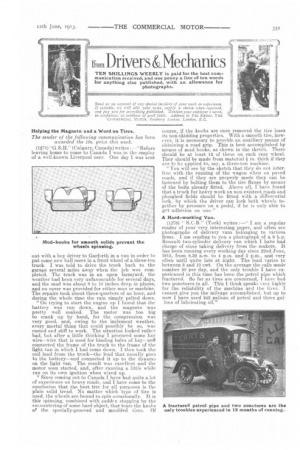Nom Drivers &Mechanics
Page 29

If you've noticed an error in this article please click here to report it so we can fix it.
TEN SHILLINGS WEEKLY is paid for the best corn. munication received, and one penny a line of ten words for anything else published, with an allowance for photographs.
Send us an account of any special incident of your worh or experience. If suitable, we will edit your notes, supPly a sketch when required, and pay you for everything published. Mention your employer's name, in confidence, as evidence of good failh. Address to The Editor, THE COMMERCIAL MOTOR, Rosebery Avenue, London, E.C.
Helping the Magneto; and a Word on Tires.
The sender of the following communication has been awarded the Ws. pri.:e this week.
(1278) "61.S.H." (Calgary, Canada) writes : —"Before leaving home to come to Canada I was in the employ of a well-known Liverpool user. One day I was sent
out with a boy driver to Garforth in a van in order to put some new ball races in a. front wheel of a three-ton truck. I was told to drive the truck back to the garage several miles away when the job was completed. The truck was in an open farmyard, the weather had been very unfavourable for several days, and the mud was about 8 to 10 inches deep in places, and no cover was provided for either man or machine. The repairs took about three-quarters of an hour, and during the whole time the rain simply pelted down.
" On trying to start the engine up I found that the battery was run down, and the magneto was pretty well soaked. The motor was too big to crank up by hand, for the compression was very good, and, owing to the inclement weather, every mortal thing that could possibly be so, was rusted and stiff to work. The situation looked rather bad, but after a little thinking I procured some hay wire—wire that is used for binding bales of hay— and connected the frame of the truck to the frame of the light van in which I had come down. I then took the coil lead from the truck—the lead that usually goes to the battery—and connected it up to the dynamo on the light van. The result was excellent and the motor soon started,: and, after running a little while ran on its own ignition when wired up. " Since coming out to Canada I have had quite a lot of experience on heavy roads, and I have come to the conclusion that. the best tire for all purposes is the plain solid tread. No matter which type of tire is used, the wheels are bound to spin occasionally. It is this spinning, combined with sudden stopping by the enwuntering of some hard object, that tears the knobs of the specially-grooved and moulded tires. Of
course, if the knobs are once removed the tire loses its non-skidding properties. With a smooth tire, however, it is necessary to provide an auxiliary means of obtaining a road grip. This is best accomplished by means of mud hooks, as shown in the sketch. There should be at least 1.2 of these on each rear wheel. They should be made from material in. thick if they are to ba applied to, say, a three-ton machine.
" You will see by the sketch that they do not interfere with the running of the wagon when on paved reads, and if they are properly made they can be fastened by bolting them to the tire flange by means of the bolts already fitted. Above all, I have found that a truck for heavy work on non-existent roads and ploughed fields should be fitted with a differential lock, by which the driver can lock both wheels together by pressure on a pedal, if he is only able to get adhesion on one."
A Hard-working Van.
(1279) " S.C.B." (York) writes :—" I am a regular reader of your very interesting paper, and often see photographs of delivery vans belonging to various firms. I am sending to you a photograph of a 9 h.p. Renault two-cylinder delivery van which I have had charge of since taking delivery from the makers. It has been running every working day since 22nd June, 1912, from 8.30 a.m. to 4 p.m. and 5 p.m., and very often until quite late at night. The load varies to between 8 and 10 cwt. On the average the calls made number 50 per day, and the only trouble I have experienced in this time has been the petrol pipe which fractured_ So far as tires are concerned, I have had two punctures in all. This I think speaks very highly for the reliability of the machine and the tires. cannot give you the mileage accomplished, but up to now I have used 242 gallons of petrol and three gallons of lubricating oil."






























